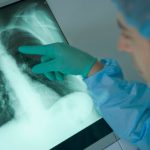 Sarcoidosis, known as a kidney stones risk, could be better diagnosed using blood monocytes or white blood cells that are critical to human immune defense.
Sarcoidosis, known as a kidney stones risk, could be better diagnosed using blood monocytes or white blood cells that are critical to human immune defense.
Sarcoidosis is an inflammatory disease that can impact organs. Under normal circumstances, our immune system defends our body against harmful substances by sending special cells to protect the organs, but in people who have sarcoidosis the inflammation that is created by harmful invaders doesn’t go away. Instead, immune cells cluster to form lumps called granulomas. These lumps can form in various organs throughout the body. The disease can be in the skin, lungs or lymph nodes. Sarcoidosis can often affect the liver, eyes and kidneys. Many people with sarcoidosis fall into the kidney stones risk category. Although it is less common, sarcoidosis can also impact the heart and brain, which can be serious.
Promising study for better sarcoidosis diagnosis
Advertisement
A promising new study out of Munich, Germany shows that analysis of a molecule called “slan” allows for more precise determination of monocyte subgroups. This could lead to a better understanding of diseases, including sarcoidosis.
Scientists analyzed blood samples from patients with sarcoidosis. In some instances they specifically looked at people who had lung disease. Sarcoidosis often leads to damage of a patient’s lungs. This is caused by the formation of nodules in the lung tissue. Although it is unclear exactly why blood monocytes play such a critical role, the researchers say their data clearly indicated which subtype of monocytes were involved in the disease. In the patients’ blood they found significant numbers of monocytes that were positive for what is known as CD16 and negative for “slan.” According to the lead scientists, these cells might play a big role in sarcoidosis.
Sarcoidosis role in kidney stones, other diseases and organ problems
 In about 90 percent of sarcoidosis cases the lungs are affected. Even people who have problems with other organs due to sarcoidoisis can still have lung disease due to the inflammatory condition. Aside from the lungs, the following are the most noticeable problem areas:
In about 90 percent of sarcoidosis cases the lungs are affected. Even people who have problems with other organs due to sarcoidoisis can still have lung disease due to the inflammatory condition. Aside from the lungs, the following are the most noticeable problem areas:
- Skin
- Musculoskeletal
- Nervous system
- Heart
- Liver
- Kidneys
As mentioned, kidney stones risk is a reality. Damage to the structure of the kidney itself can also occur, as can kidney failure. Another endocrine problem associated with sarcoidosis is something called hypopituitarism. This is when the pituitary gland at the base of the brain, which secretes eight different hormones, fails to produce some of the hormones or doesn’t produce enough of the hormones.
Approximately 25 percent of people with sarcoidosis experience skin problems. Most often it displays as tender, painful, reddish bumps or patches on the skin. Usually this can be found on the shins and sometimes it is accompanied by swollen and painful joints. Older African-American and West Indian women, who have had the disease for a long time, can experience a skin condition with purple-colored lesions on the cheeks, lips, nose and ears. Twenty-five percent of people with sarcoidosis also complain about inflammation in the eyes. This can include the eyelids, cornea, retina and lens.
Granulomas, or lumps, are present in the liver in 50 to 80 percent of people with sarcoidosis. It is normally another health issue that leads them to discover a liver problem. Liver disease can progress into hypertension in the liver or cirrhosis.
Sarcoidosis risk factors and symptoms
It seems like anyone can develop sarcoidosis. To date, only a few risk factors have been isolated. They include age, sex, race and family history (genetics). Sarcoidosis occurs between the ages of 20 and 40, most often in women. For some reason, there is a higher rate of the disease among the African-American population and this group tends to experience more severe lung problems.
 As far as sarcoidosis symptoms go, it depends of what organs are affected and how progressed the disease is. In some people, there are no symptoms, so they don’t know they have a problem until they have other testing, such as an x-ray, for some other reason.
As far as sarcoidosis symptoms go, it depends of what organs are affected and how progressed the disease is. In some people, there are no symptoms, so they don’t know they have a problem until they have other testing, such as an x-ray, for some other reason.
Here are some generalized sarcoidosis symptoms:
- Fatigue
- Swollen lymph nodes
- Fever
- Weight loss
For people who have lung disease or lung-associated problems due to sarcoidosis, symptoms can include persistent dry cough, wheezing, shortness of breath and chest pain. Skin related issues could involve a rash, lesions, color changes or nodules, which are best described as growths just under the skin. They are more likely to form around scars or tattoos.
Lifestyle changes for sarcoidosis
There really are no exact sarcoidosis causes. Doctors do believe that some people are genetically predisposed to developing the disease. They suspect that it might initially be triggered by exposure to specific bacteria, viruses, dust or chemicals; however, research in this area is ongoing.
 There may be no cure for sarcoidosis today, but it can be managed. Some people have mild symptoms that don’t require treatment, while other sarcoidosis treatment focuses on lifestyle. For example, a sarcoidosis diet includes well-balanced meals with a variety of fruits and vegetables. Avoiding large amounts of calcium rich foods such as dairy, and excessive amounts of vitamin D, are part of a sarcoidois diet. Drinking eight to 10 glasses of water a day, as well as getting six to eight hours of sleep, along with regular exercise, should be considered in any lifestyle changes you make if you are diagnosed with sarcoidosis.
There may be no cure for sarcoidosis today, but it can be managed. Some people have mild symptoms that don’t require treatment, while other sarcoidosis treatment focuses on lifestyle. For example, a sarcoidosis diet includes well-balanced meals with a variety of fruits and vegetables. Avoiding large amounts of calcium rich foods such as dairy, and excessive amounts of vitamin D, are part of a sarcoidois diet. Drinking eight to 10 glasses of water a day, as well as getting six to eight hours of sleep, along with regular exercise, should be considered in any lifestyle changes you make if you are diagnosed with sarcoidosis.
The University of Maryland Medical Centre suggests a daily multivitamin for people with sarcoidosis, as well as omega-3 fatty acid supplements, such as fish oil. One or two capsules per day could help reduce inflammation. The supplement bromelain may also help reduce inflammation in the body.
There are situations where drug therapy may be required to reduce the impact of granuloma development and prevent further organ damage. Most people turn to medication as a last resort. No matter what route you take, it is important to discuss it with a doctor first. There are some doctors who specialize in sarcoidosis treatment.
Ongoing care for sarcoidosis is important because new symptoms can pop up any time. The disease can also worsen suddenly. If you have already been diagnosed with this disease, you should visit your doctor frequently. You may have to adjust your treatment based on your symptoms. Your doctor will want to keep close tabs on you to ensure the sarcoidosis isn’t damaging any of your organs.
Related Reading:
Kidney stones recurrence risk higher with calcium supplements, lower with vitamin D
Calcium supplements increase the risk of kidney stones, but risk lowers with vitamin D. Calcium is known to be a contributing factor in the development of kidney stones, but on the other hand… Continue reading…
Advertisement
5 Things that increase your risk of kidney stones
Kidney stones are incredibly painful stones which form inside the kidneys. There are many reasons why a kidney stone would develop, such as lack of water, too much calcium build-up and excess uric acid which can occur from a high-protein diet. Continue reading…
Sources:
http://www.nhlbi.nih.gov/health/health-topics/topics
http://www.sciencedaily.com/releases/2015/10
http://www.mayoclinic.org/diseases-conditions/sarcoidosis/basics/symptoms
https://www.scripps.org/articles/1691-sarcoidosis
https://my.clevelandclinic.org/health/diseases_conditions/hic_Overview_of_Sarcoidosis/hic_Sarcoidosis_and_Your_Organs
https://umm.edu/health/medical/altmed/condition/sarcoidosis
